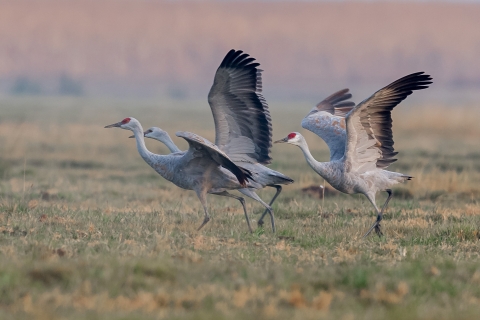About Us
The Merced National Wildlife Refuge encompasses 10,258 acres of wetlands, native grasslands, vernal pools, and riparian riparian
Definition of riparian habitat or riparian areas.
Learn more about riparian woodlands. It was established in 1951 under the Lea Act and Migratory Bird Conservation Act to attract wintering waterfowl from neighboring farmland where their foraging activities were causing crop damage. Changes to local agricultural practices and refuge management activities over the last several decades have reduced issues of wildlife causing crop damage on neighboring private lands. The refuge was also established to serve as inviolate sanctuary for migratory waterfowl.
The refuge hosts the largest wintering populations of lesser sandhill cranes and Ross’ geese along the Pacific Flyway. Each autumn as many as 20,000 cranes and 60,000 arctic-nesting geese terminate their annual migrations from Alaska and Canada to make the refuge home. Here they mingle with thousands of other visiting waterfowl, waterbirds, and shorebirds – making the refuge a true winter phenomenon.
The refuge also provides important breeding habitat for Swainson’s hawks, tri-colored blackbirds, marsh wrens, mallard, gadwall, cinnamon teal, and burrowing owls. Tri-colored blackbirds, a colonial-nesting songbird, breed in colonies of more than 25,000 pairs in robust herbaceous vegetation on the refuge. Coyotes, ground squirrels, desert cottontail rabbits, beaver, and long-tailed weasels are abundant mammal species and are present year-round.
Vernal pools are unique and special wetlands found on the refuge. These special pools form when natural shallow depressions underlaid with clay soils fill with winter rainwater. The pools come to life as they fill with water: fairy and tadpole shrimp emerge from cysts embedded in the soils the year before. The endangered tiger salamander, along with other amphibians, lay eggs that develop into tadpoles in the pools. The vast number of aquatic invertebrates found in these pools provides a food source for wintering and migrating birds as they prepare for the long flight north to their breeding grounds. As spring arrives and the water in the pools evaporates, plants such as goldfields, purple owl’s clover, and butter-and-eggs germinate producing colorful flowers in patterns of thick rings or halos around the pool basins. Once the vernal pools have dried out, Downingia and colusa grass, a rare California species, appear in the parched basins. This annual floral display of color led naturalist John Muir to describe the valley floor as the “floweriest part of the world” he had ever seen.
In addition to managing natural habitats, the refuge maintains approximately 300 acres of cultivated corn and winter wheat crops and more than 500 acres of irrigated pasture for wildlife. Not only do these managed agricultural areas provide important food sources for the tens of thousands of arctic-nesting geese and sandhill cranes that make the refuge their winter home,
they also help ensure that the birds will have adequate nutrient stores to make the long migration north to their breeding grounds. Working under cooperative agreements with the refuge, local farmers provide assistance with ground preparation, seeding, and irrigation of refuge croplands. The refuge incorporates a livestock grazing program that works in partnership with local ranchers. Grazing cattle and sheep is a management tool used by the refuge to provide and maintain short stature grasslands and help control invasive weeds. Grazing also encourages native grasslands and the wildlife that depend on them to thrive.
Our Mission
Every national wildlife refuge national wildlife refuge
A national wildlife refuge is typically a contiguous area of land and water managed by the U.S. Fish and Wildlife Service for the conservation and, where appropriate, restoration of fish, wildlife and plant resources and their habitats for the benefit of present and future generations of Americans.
Learn more about national wildlife refuge was created for a special purpose. Some were created to protect migratory birds, others to protect threatened or endangered species or unique habitats, while others fulfill another special purpose. All activities allowed on refuges must be evaluated to make sure each activity will not conflict with the reason the refuge was founded.
The refuge was established in 1951 under the Lea Act to attract wintering waterfowl away from adjacent farmland where their foraging activities were causing crop damage. The refuge was also established under the Migratory Bird Conservation Act to serve as inviolate sanctuary for migratory waterfowl.
Other Facilities in this Complex
The Merced NWR is part of the San Luis NWR Complex. A national wildlife refuge national wildlife refuge
A national wildlife refuge is typically a contiguous area of land and water managed by the U.S. Fish and Wildlife Service for the conservation and, where appropriate, restoration of fish, wildlife and plant resources and their habitats for the benefit of present and future generations of Americans.
Learn more about national wildlife refuge complex is an administrative grouping of two or more refuges, wildlife management areas or other refuge conservation areas that are primarily managed from a central office location. Refuges are grouped into a complex structure structure
Something temporarily or permanently constructed, built, or placed; and constructed of natural or manufactured parts including, but not limited to, a building, shed, cabin, porch, bridge, walkway, stair steps, sign, landing, platform, dock, rack, fence, telecommunication device, antennae, fish cleaning table, satellite dish/mount, or well head.
Learn more about structure because they occur in a similar ecological region, such as a watershed or specific habitat type, and have a related purpose and management needs. Typically, a project leader or complex manager oversees the general management of all refuges within the complex and refuge managers are responsible for operations at specific refuges. Supporting staff, composed of administrative, law enforcement, refuge manager, biological, fire, visitor services, and maintenance professionals, are centrally located and support all refuges within the complex.
Other units in the San Luis NWR Complex include the San Luis NWR, San Joaquin River NWR, and Grasslands Wildlife Management Area.








